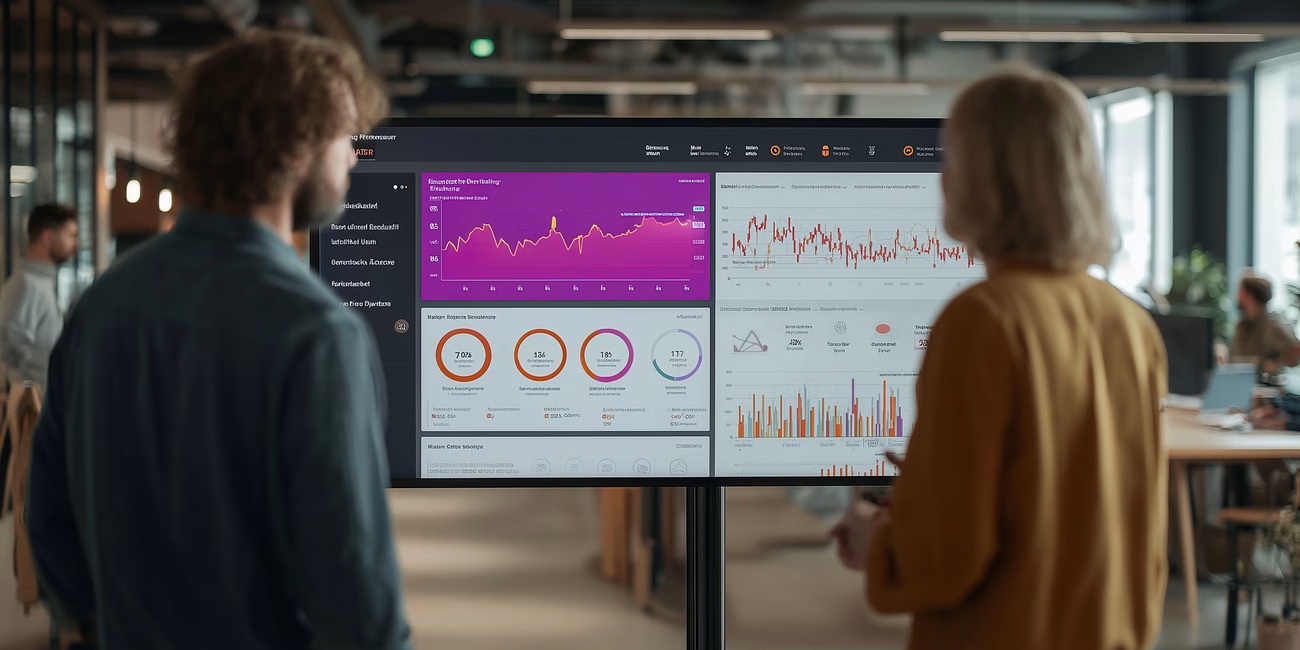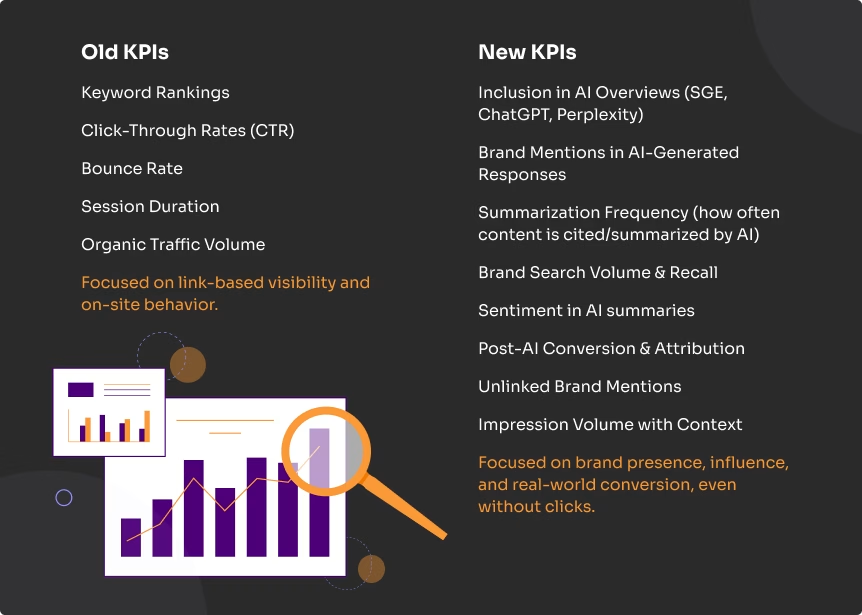
KPIs: once the guiding stars of every digital marketer, are being thrown off orbit. As generative AI reshapes how users search, click, and make decisions, businesses can’t afford to rely on yesterday’s metrics. The old metrics aren’t just outdated, they’re misleading.
Let’s be honest: this isn’t an easy time for digital marketers. It never really was. SEO has lived in controlled chaos for years – chasing ever-shifting algorithms, decoding vague Google algorithm updates, and trying to prove ROI with tidy reports and up-and-to-the-right graphs.
But AI-driven search brings a new layer of complexity. CEOs want proof of performance. Clients want measurable ROI backed by polished reports, complete with soaring charts and numbers that climb like clockwork. And now, AI tools are giving users direct answers cutting websites out of the journey entirely. So if you’re still laser-focused on traditional rankings, such as keyword rankings and click-through rates, it’s time to recalibrate.
We need to acknowledge that in this new digital landscape, traffic alone is no longer a metric you can rely on, at least not the only one. With the rise of zero-click searches and AI Overviews powered by LLMs delivering direct answers, it’s time to ask yourself: what are the right KPIs for AI-driven search?
This article is for business owners, marketing leads, and SEO professionals who are done chasing vanity metrics. It’s about measuring what truly matters in an AI-driven search landscape.
How Generative AI Is Rewriting the Search Playbook

Search is no longer about ranking first and waiting for the clicks to roll in. The classic “10 blue links” model is being replaced by a more dynamic and far less click-dependent ecosystem.
With SGE, Bing’s chat-style responses, and tools like ChatGPT and Perplexity shaping user behavior, the way content is discovered and engaged with has fundamentally changed.
Here’s what’s defining the new rules:
1. AI Snapshots Are Replacing Traditional Results
Generative AI doesn’t just list content, it summarizes it. Google’s AI Overviews deliver direct answers in a boxed summary. Your content might power that summary, but users may never see your link, much less click it.
2. Chat-Based Engines Bypass Traditional Citations
Chatbots like Claude and Perplexity pull from multiple web sources without citing them in a visible or trackable way. Your insights may be used, but attribution is increasingly opaque.
3. Zero-Click Searches Are Rising
SparkToro reported that over 65% of Google searches in 2020 didn’t result in a click. That percentage is growing, especially with AI giving instant answers.
4. Click-Through Rates Are Dropping
With fewer reasons to click, organic traffic is naturally declining. But don’t confuse lower traffic with lower visibility. Your brand could still be influencing decisions, just behind the scenes, inside AI-generated summaries.
5. The User Journey Is No Longer Linear
Users are no longer entering at the homepage and navigating neatly. They’re asking AI a series of questions, digging deeper, jumping between platforms, and often skipping your site entirely in the process. Discovery now happens in fragments.
6. Structured Data and Brand Authority Carry More Weight
Schema markup, entity recognition, and semantic clarity are critical. AI systems rely on this structure to identify credible sources and surface relevant information. If your brand isn’t clearly defined, connected, and trusted, you won’t make the cut.
This shift means content isn’t just being found: it’s being interpreted, summarized, and remixed. Your insights might shape the response, but the user may never know it came from you. That changes how performance is measured and it forces businesses to rethink what visibility and success actually look like.
Why Traditional KPIs No Longer Tell the Whole Story

Traditional KPIs like keyword rankings, bounce rates, and average session duration were built for a different era, when users typed a query, scanned a list of blue links, and clicked through to a website.
But the landscape has changed. In an AI-driven search environment, visibility isn’t just about showing up – it’s about showing up in the right context, with the right level of authority, at the right stage in the user journey.
Let’s be specific:
Keyword Rankings ≠ Visibility
Your page might rank #1 for a query, but if that query triggers an AI Overview, SGE snapshot, or direct answer box, your link could be buried or omitted entirely. Being technically “on top” now doesn’t mean being seen or considered.
Traffic ≠ Impact
A visit to your homepage doesn’t tell you whether your brand was cited in a ChatGPT summary, mentioned in Perplexity’s sources, or paraphrased in Gemini. AI tools are increasingly shaping decisions before a user reaches your site, and if your brand is missing from those conversations, the traffic you are getting may not be from the audiences that actually matter.
Bounce rate & session duration
If the user never clicks in the first place because the answer is already in the AI box, these metrics lose meaning. You can’t measure engagement on a session that never existed.
Marketers still holding tight to these legacy KPIs may feel like they’re tracking performance, but what they’re really tracking is surface-level noise. Meanwhile, the actual drivers of trust, influence, and purchase decisions are happening elsewhere.
This is where most reporting frameworks break down. They don’t account for how LLMs repackage your content. They don’t measure how often your brand is summarized, cited, or simply recognized by AI systems trained on vast pools of data. And they certainly don’t capture whether you’re seen as a reliable authority or just another web page in the index.
Smart marketers are moving past vanity stats and embracing metrics that map to real visibility and real outcomes in the generative search ecosystem. If your dashboard still looks like it did in 2018, with CTR, bounce rate, and not much else, it’s time to rethink and introduce new metrics that better reflect today’s reality.
New KPIs Smarter Businesses Are Measuring Instead

The most forward-thinking teams are reorienting around a new set of KPIs that reflect behavior and business impact, not just search engine preferences.
Here’s what they’re paying attention to:
- Conversion Rates: Are you turning visitors (or readers of AI answers) into leads or customers?
- Qualified Leads: Are the right people finding you?
- Customer Acquisition Costs (CAC): Are you spending effectively to gain paying users?
- Customer Lifetime Value (CLV): Is your content attracting long-term buyers?
And they’re layering in behavioral signals that AI search doesn’t ignore:
- Engagement: How long users stay, what they click, whether they return?
- Retention: Are people coming back? Are they searching your brand directly?
- Brand Recall: Are you mentioned in AI-generated answers, even when users don’t click?
It’s clear that KPIs are shifting toward brand presence, influence, and action and moving away from sheer volume. In fact, brand visibility, brand authority, and brand search volume are quickly becoming essential metrics and tracking them is no longer optional. Their growing influence deserves more than a passing mention, which is why we’ll be dedicating an entire blog post to explore their impact in depth.
Why Traditional SEO KPIs Fall Short

Let’s be blunt: the traditional KPIs weren’t built for this new AI-first environment. They measure what used to matter, not what drives actual results today.
Take keyword rankings.
Being in the top position on a search results page used to mean visibility. Today, it might mean you’re tucked beneath a glowing AI-generated box that already answered the user’s question. So yes, you ranked. But did anyone care?
Then there’s traffic.
A spike in visits feels good on paper, but without knowing who those users are or what they actually did, it’s a vanity metric. If they landed on your site by accident, bounced in five seconds, or never fit your target profile in the first place, the number does nothing for your bottom line.
Bounce rate? Session duration?
These metrics fall apart when AI search gives users everything they need without ever clicking through. Maybe they got the answer straight from a generative summary. Maybe they clicked, skimmed, and left satisfied. Either way, your report says “high bounce,” but that doesn’t necessarily mean “low value.”
Here’s where things shift.
Search engines and LLMs are increasingly treating your content as raw material. They use it, quote it, summarize it, but they don’t always send users your way. Your site becomes the background actor while the AI delivers the lines.
So if you’re still measuring success with clicks and dwell time, you’re missing what actually drives influence. The real question is:
- Are you being cited by AI tools?
- Is your brand being mentioned in generative responses?
- Are you present in the summaries shaping your audience’s decisions?
If you’re not tracking those things, you’re effectively blind to how your brand performs in the most influential layer of modern search. KPIs now need to account for where your brand shows up, how it’s being interpreted, and whether it’s seen as an authority worth citing. AI may use you without linking you. That still matters.
If your reporting isn’t answering whether your brand is present in the AI layer of search, it’s not just incomplete, it’s outdated. Because in a world where AI decides what the user sees first, being part of the answer matters more than being part of the index.
Redefining Success and Choosing Smarter KPIs

Success in search is no longer measured by how many users landed on your homepage. It’s about whether your brand shows up when it matters.
Visibility is no longer tied to page one rankings. It’s tied to inclusion, influence, and the ability to convert attention into action across fragmented touchpoints. Let’s break that down.
1. Visibility: Are You in the Conversation?
In traditional SEO, ranking meant visibility. In today’s AI-dominated landscape, it’s about whether you’re included in the answer itself.
- Does your brand show up in AI Overviews?
- Are you mentioned in responses from tools like ChatGPT, Perplexity, or Gemini?
- Is your product being recommended in voice search via Alexa or Google Assistant?
If the answer is no, it doesn’t matter what your ranking is. You’re absent from the space where real user decisions are happening.
2. Influence: Are You Shaping the Narrative?
It’s not just about being mentioned, it’s about how you’re mentioned. AI tools are synthesizing knowledge across domains. The brands that consistently contribute high-quality, well-structured content are the ones that influence the narrative. This influence shows up in:
- Sentiment of AI summaries: Are you positioned as credible or questionable?
- Topical consistency: Does your brand show up across related queries?
- Entity-level optimization: Is Google connecting you to the topics you want to own?
Influence in the AI age is earned through relevance, clarity, and trustworthiness, not aggressive backlink profiles or keyword stuffing.
3. Conversion: Are You Turning Exposure Into Action?
Visibility without action is noise. If your brand shows up in an AI snapshot but no one searches for you afterward, that’s attention wasted, not influence gained.
Look at the moments that matter:
- Did someone search your brand by name after reading about you in an AI answer?
- Did they convert after engaging with your email or paid social-channels often revisited post-AI search?
- Are you measuring post-interaction behavior, not just clicks?
The smart digital marketing agencies track where leads come from, why they converted, and how AI-assisted discovery contributed to that journey.
The Metrics That Actually Matter in AI-Driven Search

To move beyond old metrics, here’s what should be on your dashboard:
1. Inclusion in GenAI Platforms
- Mention frequency in tools like ChatGPT, Claude, Perplexity, and Gemini
- Presence in Google’s SGE snapshots
- Appearance in AI-generated lists, comparisons, or recommendations
- Visibility in voice search assistants like Alexa and Google Assistant
2. Content Performance Beyond Clicks
- Summarization frequency: How often is your content used as a source for AI answers?
- AI-level engagement metrics, like scroll depth in native apps or featured snippet dwell time.
- Topic alignment: Are your pages structured in a way that matches how users phrase real questions?
3. Trust and Topical Authority
- Unlinked brand mentions: Recognition without referral is still a signal of influence.
- Structured data presence: Are you feeding AI the information it needs to trust you?
- Sentiment analysis: Are you showing up as a leader or just a name on a list?
4. Brand Visibility Metrics
- Brand search volume: Are users searching for you directly?
- Natural language visibility: Does your brand appear in AI-generated summaries without being forced?
- Topic associations: Are you consistently connected to your core industry themes?
5. Conversion and Revenue Attribution
- Cross-channel impact: Are organic search, email, and social playing new roles post-AI discovery?
- Post-AI conversions: Did someone convert after learning about you from an AI tool?
6. Impressions (With Context)
- Impression volume: How often is your content being displayed across SERPs, AI snapshots, and content feeds?
- Contextual relevance: Are these impressions tied to qualified topics and user intent, or are they scattered and meaningless?
- Impressions alone aren’t a win, but tracking when, where, and why you’re being surfaced can reveal opportunities to strengthen your entity presence and refine content targeting.
These KPIs offer a more complete and useful picture of how your brand performs in the real world. This isn’t about abandoning SEO. It’s about realigning your metrics to match how discovery, trust, and conversion actually work now.
The brands paying attention to these signals are the ones quietly winning, while everyone else keeps chasing pageviews that no longer tell the full story.
Old KPIs vs. New KPIs

Old metrics track on-site behavior – new ones reveal how present, recognized, and influential your brand truly is in an AI-driven search landscape.
Tools for Tracking AI Visibility and Brand Impact

You won’t find all this data in your old Google Analytics dashboard. Tracking meaningful KPIs today means using tools built for the AI-driven landscape – and knowing exactly where to look to turn visibility into real outcomes.
Here’s where to look:
1. Emerging Tools
Tools like Profound, WAIKAY, ZipTie, and Otterly are built specifically for tracking brand inclusion and exposure across generative AI platforms. They monitor how often your content is referenced, summarized, or surfaced in AI-generated answers.
2. Legacy Tools with AI Features
Platforms like Semrush AI Toolkit, Ahrefs (via mention alerts), and Authoritas are evolving to include AI visibility metrics. These tools offer early-stage tracking for unlinked mentions, entity strength, and SERP feature performance.
3. Manual Queries
Sometimes, a direct check is still the fastest route. Ask ChatGPT, Perplexity, or Claude how they’d answer a query in your niche. Then assess whether your brand appears in the response and how it’s positioned.
4. Structured Data Testing
Use Google’s Rich Results Test and Schema.org validators to confirm whether your site is feeding AI engines with clear, reliable entity signals. Proper structured data improves your chances of being surfaced and cited.
5. Query Landscape Tools
Platforms like AlsoAsked and AnswerThePublic help uncover how users are phrasing questions that AI tools aim to answer. If you’re not appearing for those query patterns, your content structure and semantics need work.
If you want to measure what actually matters in generative search, these tools are your new foundation.
How to Align New KPIs With Your Business Goals

Raw data means nothing without strategic alignment. KPIs need to reflect what drives actual outcomes for your business, not just what looks impressive in a monthly report.
Choosing the right KPIs starts with a simple question: What does success look like for your business model?
For E-Commerce Brands
Your focus should be on product visibility in AI results, brand trust signals, and conversion attribution across fragmented journeys. If users are asking Perplexity or Google’s SGE for product comparisons, the goal isn’t just to appear – it’s to be cited as a top recommendation.
Key KPIs to track:
- Inclusion in AI product summaries
- Brand search volume growth
- Conversion rates from post-AI discovery touchpoints
- Checkout attribution across organic and AI-driven channels
But, if your product is listed in an AI-generated recommendation but doesn’t lead to a click, a search, or a purchase, it’s not helping your bottom line.
For B2B Companies
Longer sales cycles require different metrics. Visibility in expert responses from LLMs and trusted mention in AI-assisted research matters far more than a fleeting click. In B2B, influence and credibility are currency.
Key KPIs to track:
- Brand mentions in AI tools across mid-funnel queries
- Share of voice compared to competitors
- Qualified leads sourced from AI-referred paths
- Engagement with high-intent assets (whitepapers, calculators, etc.)
But, if your brand is mentioned in a generative response but no decision-makers follow up, that’s surface-level exposure, not pipeline growth.
For Local Service Providers
Discovery is driven by voice assistants, local packs, and hyper-specific queries. It’s about being the answer when someone nearby needs help now.
Key KPIs to track:
- Inclusion in voice search results for service-specific terms
- Google Business Profile visibility across AI surfaces
- Local brand search trends
- Call or booking conversions attributed to AI-boosted visibility
If you’re cited in a voice search and still not seeing an increase in calls or bookings, the visibility clearly isn’t translating into results.
Precise KPIs allow you to build real performance systems that align with both how people search and how your business operates. Each KPIs should meet these criteria:
- Actionable: Will this data inform a clear decision or next step?
- Aligned: Does this KPI reflect your business model, sales cycle, and buyer behavior?
- Specific: “Engagement” is vague. “Qualified demo bookings from AI-sourced leads” is measurable and useful.
Final Thoughts
Traditional KPIs reflect a version of the internet that’s fading fast. Rankings and traffic once told the story. Now, they tell part of it. Visibility, influence, and conversion in this new environment require more nuanced, context-aware metrics.
Generative AI hasn’t replaced SEO. It has forced it to grow up. The businesses that are adapting aren’t chasing clicks – they’re tracking how their brand is being cited, summarized, and remembered. That shift is where the real value lies.
But, there’s no one-size-fits-all KPI set. What matters is choosing metrics that reflect your goals, using tools designed for how discovery actually happens now. When KPIs are tied to real business outcomes, they stop being noise and start becoming insight.
That’s the difference between the average and the successful. This is where working with the right SEO partner becomes non-negotiable. A data-driven SEO agency like Ginger IT Solutions brings together structured data, content strategy, and intelligent tracking, so your brand stays visible, even when the clicks don’t come.
Because being discoverable in an AI-first world isn’t a bonus. It’s the baseline.
FAQs
1. What are generative search KPIs?
KPIs that measure visibility, brand presence, and engagement within AI-generated search results and conversational engines.
2. How to optimise for AI search?
Use structured data, build topical authority, and monitor unlinked mentions across tools like ChatGPT, SGE, and Perplexity. Semantic relevance is key.
3. How do I know if my site is featured in AI overviews?
Manually query AI tools or use platforms like Profound and ZipTie. Track brand mentions and analyze sentiment in AI summaries.
4. Are rankings and traffic still reliable KPIs?
Not on their own. They only show part of the picture in AI-driven search.
5. Do unlinked brand mentions matter?
Absolutely. AI may reference your content without linking to it and visibility still counts.
6. Do I really need structured data?
Yes. Schema is essential for AI engines to recognize and trust your content.

